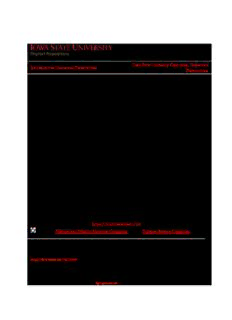
The effects on tensile, shear, and adhesive mechanical properties when recycled epoxy/fiberglass PDF
Preview The effects on tensile, shear, and adhesive mechanical properties when recycled epoxy/fiberglass
Iowa State University Capstones, Theses and Retrospective Theses and Dissertations Dissertations 1998 The effects on tensile, shear, and adhesive mechanical properties when recycled epoxy/ fiberglass is used as an alternative for glass microballoons in fiberglass foam core sandwiches Dru Matthew Wilson Iowa State University Follow this and additional works at:https://lib.dr.iastate.edu/rtd Part of thePolymer and Organic Materials Commons, and thePolymer Science Commons Recommended Citation Wilson, Dru Matthew, "The effects on tensile, shear, and adhesive mechanical properties when recycled epoxy/fiberglass is used as an alternative for glass microballoons in fiberglass foam core sandwiches " (1998).Retrospective Theses and Dissertations. 12538. https://lib.dr.iastate.edu/rtd/12538 This Dissertation is brought to you for free and open access by the Iowa State University Capstones, Theses and Dissertations at Iowa State University Digital Repository. It has been accepted for inclusion in Retrospective Theses and Dissertations by an authorized administrator of Iowa State University Digital Repository. For more information, please [email protected]. INFORMATION TO USERS This manuscript has been reproduced from the microfilm master. UMI films the text directly from the original or copy submitted. Thus, some thesis and dissertation copies are in typewriter face, while others may be from any type of computer printer. The quality of this reproduction is dependent upon the quality of the copy submitted. Broken or indistinct print, colored or poor quality illustrations and photographs, print bleedthrough, substandard margins, and improper alignment can adversely affect reproduction. In the unlikely event that the author did not send UMI a complete manuscript and there are missing pages, these will be noted. Also, if unauthorized copyright material had to be removed, a note will indicate the deletion. Oversize materials (e.g., maps, drawings, charts) are reproduced by sectioning the original, beginning at the upper left-hand comer and continuing from left to right in equal sections with small overlaps. Each original is also photographed in one exposure and is included in reduced form at the back of the book. Photographs included in the original manuscript have been reproduced xerographically in this copy. Higher quality 6" x 9" black and white photographic prints are available for any photographs or illustrations appearing in this copy for an additional charge. Contact UMI directly to order. UMI A Bell & Howell Infonnation Company 300 North Zeeb Road, Ann Aibor MI 48106-1346 USA 313/761^700 800/521-0600 NOTE TO USERS The original manuscript received by UMI contains pages with indistinct print. Pages were microfilmed as received. This reproduction is the best copy available UMI The effects on tensile, shear, and adhesive mechanical properties when recycled epoxy/fiberglass is used as an alternative for glass microballoons in fiberglass foam core sandwiches by Dru Matthew Wilson A dissertation submitted to the graduate faculty in partial fulfillment of the requirements for the degree of DOCTOR OF PHILOSOPHY Major; Industrial Education and Technology Major Professor: Roger A. Smith Iowa State University Ames, Iowa 1998 UMI Number: 9911656 UMI Microform 9911656 Copyright 1999, by UMI Company. Ail rights reserved. This microform edition is protected against unauthorized copying under Title 17, United States Code. UMI 300 North Zeeb Road Ann Arbor, MI 48103 11 Graduate College Iowa State University This is to certify that the Doctoral dissertation of Dru Matthew Wilson has met the dissertation requirements of low^ State University Signature was redacted for privacy. Major Professor Signature was redacted for privacy. For the Major Program Signature was redacted for privacy. Foi^he Graduate College Ill TABLE OF CONTENTS LIST OF HGURES vi LIST OF TABLES ix ABSTRACT xi CHAPTER 1. INTRODUCTION 1 Background of the Study 1 Composite Sandwiches 1 Recycling of Polymer Reinforced Composites 4 Problem of the Study 6 Purpose of the Study 7 Ne^ for the Study 7 Hypotheses of the Study 9 Assumptions of the Study 12 Limitations of the Study 12 Procedure of the Study 13 Definitions of Terms 13 CHAPTER 2. REVIEW OF LITERATURE 16 Envirorunentai Issues 16 Recycling 17 Plastic Materials 17 Composite Materials 18 Composite Material Theory 24 Composite Foam Sandwich Panels 26 Foam Characteristics 27 Filler Percentage Ratios and Particle Size Characteristics 28 CHAPTER 3. METHODOLOGY 32 Population of the Study 32 Sample of the Study 32 Preparation of Sample Sandwich Test Panels 33 Epoxy Resin 33 Slurry 34 Recycled Epoxy/Fiberglass Powder 35 Fabrication of the Samples for the Flatwise Tensile Strength Test 35 Fabrication of the Samples for the Shear Strength Test 37 Fabrication of the Samples for the Peel (Adhesive) Strength Test 39 Variables of the Study 41 IV Independent Variables 42 Dependent Variables 42 Data Collection Methods 43 Instrumentation 44 Flatwise Tensile Strength Test 44 Shear Strength Test 45 Peel (Adhesion) Strength Test 45 Data Input 46 Statistical Analysis of Data 48 CHAPTER 4. FINDINGS 49 Flatwise Tensile Test 49 Results of ANOVA for Strength of Flatwise Tensile Test 49 Filler Type 53 Foam Density 54 Filler Percentage Ratio 56 Main Effect Interactions 59 Results of ANOVA for the Weight of Flatwise Tensile Test Sandwiches 64 Filler Type 66 Foam Density 71 Filler Percentage Ratio 73 Main Effect Interactions 74 Shear Test 81 Results of ANOVA for Strength of Shear Test 81 Filler Type 84 Foam Density 87 Filler Percentage Ratio 89 Main Effect Interactions 90 Results of ANOVA for the Weight of Shear Test Sandwiches 95 Filler Type 99 Foam Density 102 Filler Percentage Ratio 103 Main Effect Interactions 105 Peel (Adhesion) Test 112 Results of ANOVA for Strength of Peel (Adhesion) Test 112 Filler Type 115 Foam Density 118 Filler Percentage Ratio 120 Main Effect Interactions 121 Results of ANOVA for the Weight of Peel (Adhesion) Test Sandwiches 128 Filler Type 130 Foam Density 132 Filler Percentage Ratio 136 Main Effect Interactions 137
